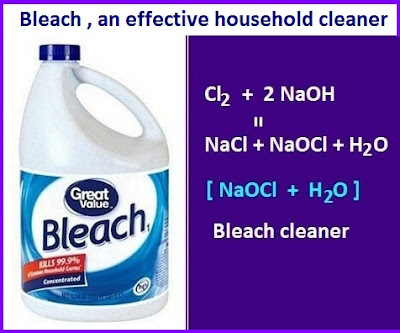What is ammonia and bleach?
Ammonia
Ammonia and bleach are both inexpensive and effective household cleaners.
Household ammonia is a solution of NH3 in water, and is used as a general purpose cleaner for many surfaces.
Like bleach, ammonia is also an effective household item cleaner. Ammonia is also a
great cleaner.
Approximately
5% to 10% ammonia solution is usually used as
household cleaner.
Household
ammonia is usually 70% water, 30% ammonium hydroxide (H2O + NH4OH). Like bleach, ammonia also acts as a disinfectant
and kills germs.
Read more : Nitric acid details
Bleach
Usually bleach is a mixture of chlorine, caustic soda and
water. These chemicals make bleach a powerful disinfectant.
Household bleach is usually a mixture of 91% water, 9%
sodium hypochlorite (H2O + NaOCl).
Bleach clears stains from white clothes and makes them
white. Also, bleach is a great cleaner for molds.
Bleach
is much more effective than ammonia as a cleanser. Because of bleach is a
powerful oxidizing agent.
For
this reason, we most commonly use it to remove stains from clothing and
household fabrics.
It cleans clothes and other household items
through oxidation. But bleach is very
effective in keeping our houses germ free.
This is because it kills the fungus and removes mold and fungus stains and is related to the growth of unwanted algae and algae.
Even homemade bleach solutions are strong enough to kill
dangerous germs.
What is ammonia and bleach use for?
Ammonia
uses
Ammonia is an important and
effective household item cleaner. It is good for cleaning surfaces like
bathroom tiles and kitchen counters.
It is also great for cleaning glass, porcelain, stainlesssteel, jewelry and windows. Ammonia cleans hard surfaces without lightening them.
Ammonia is used as a cleaning agent for cleaning oily
substances or grease. It
is also frequently used for cleaning ovens and soaking items to loosen baked-on
grime.
Ammonia cleaner has very little effect on
viruses. But ammonia acts as a disinfectant for some common bacteria.
Bleach uses
Bleach
is commonly used to lighten and illuminate fabrics. Bleach is used to clean stains from white clothing.
Bleach solution can also be used on dishes and other hard
surfaces.
Bleach, a great cleaner for mold. It is used as a disinfectant and to control
the growth of unwanted algae and algae.
Toxicity of ammonia and bleach
Toxicity of ammonia
Ammonia
is a reducing as well as volatile substance. As a household cleaner it does not
damage the material. Ammonia is less toxic
than bleach.
But
ammonia is harmful to the eyes. So you have to use it carefully as a household
cleaner. Because of, if ammonia gets in the
eyes, the eyes can be damaged.
Toxicity
of bleach
Bleach is a toxic and harmful substance. If its bleaching comes in contact with the eyes, then
people can become blind.
Exposure can cause irritation to the eyes, face, lungs and
skin. Patients with asthma are at risk for bleach exposure.
Smoke can cause deterioration of the lining of
the lungs and esophagus, resulting in long-term damage. A toxic mixture is obtained by mixing ammonia and bleach.
The
mixture of ammonia and bleach will produce chlorine gas which is incredibly
dangerous, especially in hard places like bathrooms.
Conclusion
Ammonia and bleach are both hazardous substances.
Individually bleach is more toxic than ammonia. Again when ammonia and
bleach are mixed a toxic mixture is formed.
This is because a mixture of ammonia and bleach will
produce chlorine gas which is toxic and possibly deadly.
Especially in hard places like bathrooms. For this reason,
ammonia and bleach should not be combined for any purpose
What is anhydrous ammonia?
NH3 gas is produced in the laboratory by heating a mixture
of NH4Cl and dry Ca (OH) 2 in a 1: 3 ratios.
This ammonia gas is mixed with water vapor. Dry and pure ammonia is
obtained by passing the obtained ammonia gas through CaO, NaOH or KOH.
When pressed and cooled, ammonia becomes
liquid very easily. This ammonia is called anhydrous NH3.
Ammonia molecules are associated both in solid or liquid
state through the formation of inter-molecular hydrogen bond.
The boiling point of anhydrous liquid ammonia is 239.6K and
the freezing point of liquid is 198.4K. Liquid ammonia is an important non
aqueous solvent.
Ammonia, in liquid state under goes self ionization. For
this reason, many polar compounds are dissolved in liquid ammonia.
What is aqueous ammonia?
Ammonia
is highly soluble in water. Because of ammonia molecule forms inter-molecular
H-bond with water molecule.
It
has been found that about 1150 cc of ammonia gas is dissolved in 1 cc water at
NTP. Ammonia dissolves in water and form NH4OH.
The
aqueous solution of ammonia is known as aqueous ammonia. It is also known as
ammonia-water or ammonia liquor.
The aqueous solution of ammonia is mild basic in nature.
Its aqueous solution turns red litmus into blue.
The
concentrated aqueous solution of ammonia is known as liquor ammonia. Liquor ammonia contains 35% ammonia. Its specific
density relative is 0.88. Liquid NH3 is a non aqueous solvent.
Is ammonia toxic in nature?
In general, ammonia solution does not cause serious effects
on the body of humans and other mammals.
This
is because the biological mechanism of the human body prevents the growth of
ammonia in the blood stream.
But the concentration aqueous solution of
ammonia is very harmful to our eyes.
For some reason, when ammonia comes in contact with our
eyes, it causes eye irritation. As a result, our eyes may be damaged.
Again,
ammonia even at dilute concentrations is highly toxic to aquatic animals, and
for this reason it is classified as dangerous for the environment.
- What is ammonia and bleach?
- Toxicity of ammonia and bleach
- What is anhydrous ammonia?
- What is aqueous ammonia?
- Is ammonia toxic in nature?
ammonia and bleach, anhydrous ammonia, toxicity of
ammonia and bleach, aqueous ammonia, ammonia toxic,











No comments:
Post a Comment